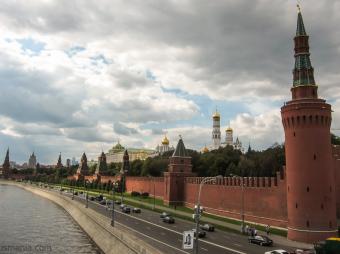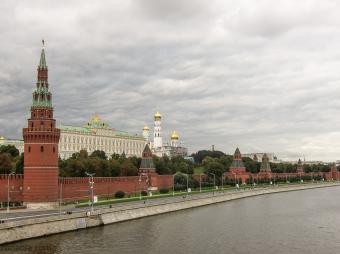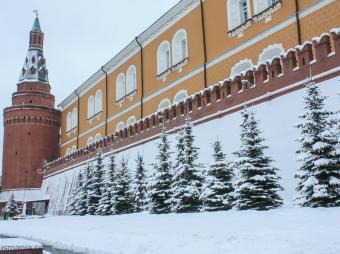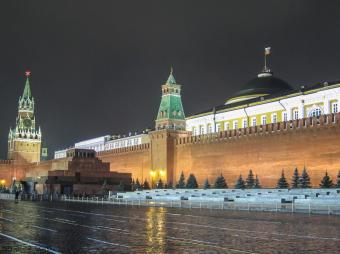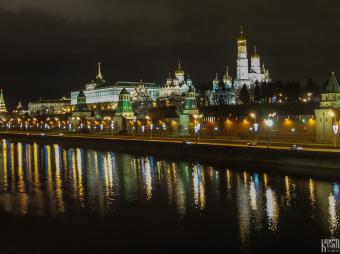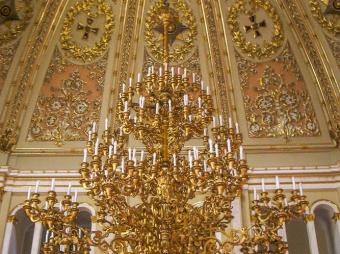Around the Kremlin
Moscow Kremlin
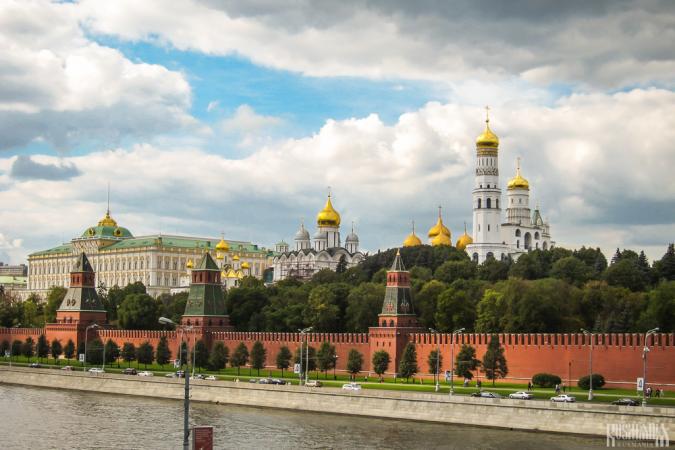 Moscow Kremlin (August 2011)
Moscow Kremlin (August 2011)
The word kremlin is used to describe fortresses found in many Russian cities, but when you talk about the Kremlin it is the Moscow Kremlin one thinks of. The first version of the Moscow Kremlin was erected in the current location on Borovitsky Hill in 1156. This original version was made out of wood and stood until it was destroyed in 1238 during the Mongol-Tatar Invasion. Afterwards, new walls made out of oak were put up in 1339. The first stone walls were erected between 1366 and 1368 during the reign of Grand Prince Dmitri Donskoy using white limestone. After the fall of Constantinople and the marriage of Grand Prince Ivan III to the niece of the last Byzantine Empire, Moscow saw itself as the new centre of the Orthodox world and accordingly Ivan III set out on an ambitious building plan to improve the Moscow Kremlin to make it suitable for Moscow's new elevated status. As part of this redevelopment new walls and towers were raised by Italian masters between 1485 and 1495.
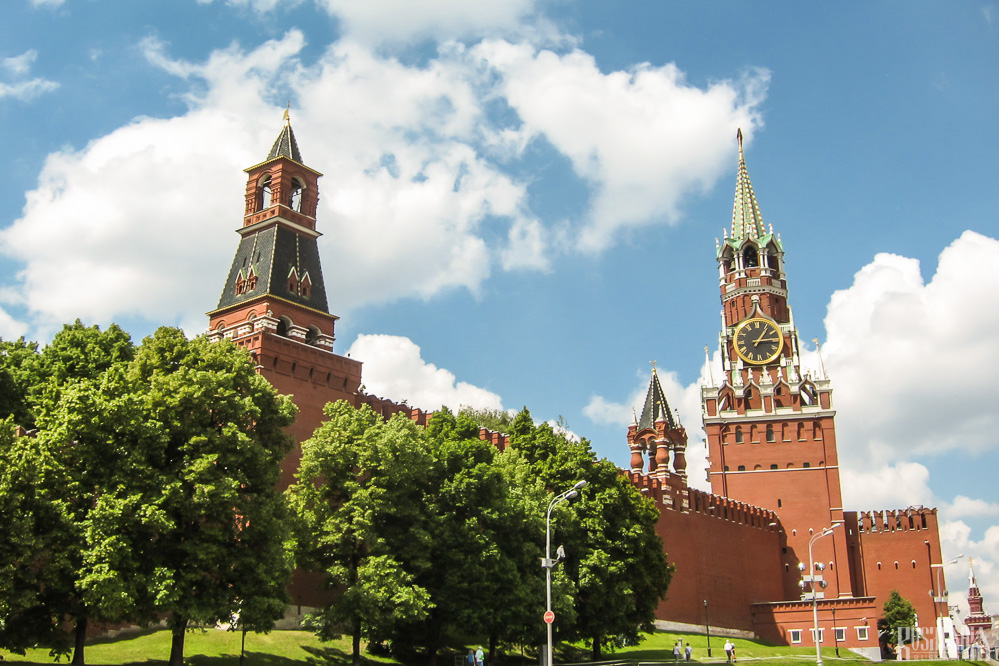 Moscow Kremlin (June 2011)
Moscow Kremlin (June 2011)
During the Times of Troubles, the Kremlin was occupied by Polish-Lithuanian troops from 1610 to 1612 until it was liberated by the volunteer army of Minin and Pozharsky. In the early 18th century the Kremlin lost some of its significance as Peter the Great moved the capital to the newly-founded St Petersburg. In 1812, Napoleon briefly occupied the Kremlin and ordered it be blown up upon his retreat from the city. Although several of the fuses failed, a large part of the Kremlin was damaged and later rebuilt from 1816 to 1819.
After the Revolution, the Kremlin once again became the residence for the head of state. Under Stalin many of the Kremlin's imperial signs were replaced with Soviet ones, such as the double-headed eagles on the towers being replaced with red stars. Several buildings inside were also destroyed including the Saviour Cathedral na Boru (the first stone church in Moscow dating from 1330), the Chudov Monastery and the Voznesensky Convent.
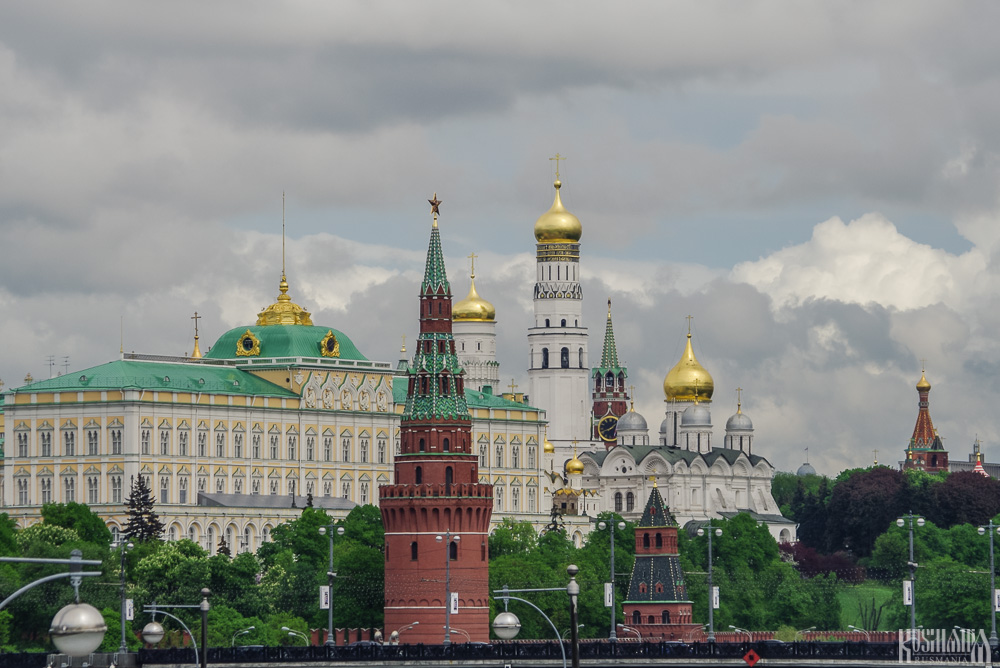 Moscow Kremlin (August 2011)
Moscow Kremlin (August 2011)
Since 1955 the Kremlin has been open to tourists and today the site is both the seat of the Russian president and a tourist attraction run as the Moscow Kremlin State Historical and Cultural Museum-Reserve. In 1990 the Kremlin was inscribed on the UNESCO World Heritage List.Access to the kremlin is therefore understandably restricted. To visit the kremlin you need to buy one of several types of ticket: a standard Sobornaya Ploschad ticket which allows access to Sobornaya Ploschad and the cathedrals there, an Ivan the Great Bell Tower ticket which allows access to the bell tower and Sobornaya Ploschad, or a ticket to just one of the exhibits located inside the One-Pillar Chamber or the Dormition Belfry. The kremlin's palaces are not generally open to the public and are only used for governmental purposes, although some travel agencies do arrange special guided tours.
Standard tickets are sold in the special ticket booths in Aleksandrovsky Gardens and you enter through the Kutafya Tower which leads to the Trinity Tower via the Troitsky Bridge. You will need to pass through metal detectors here before being allowed in. No big bags are permitted, but there is a cloakroom located in Aleksandrovsky Gardens next to the Troitsky Bridge.
Kremlin Arsenal, Senate and Presidium
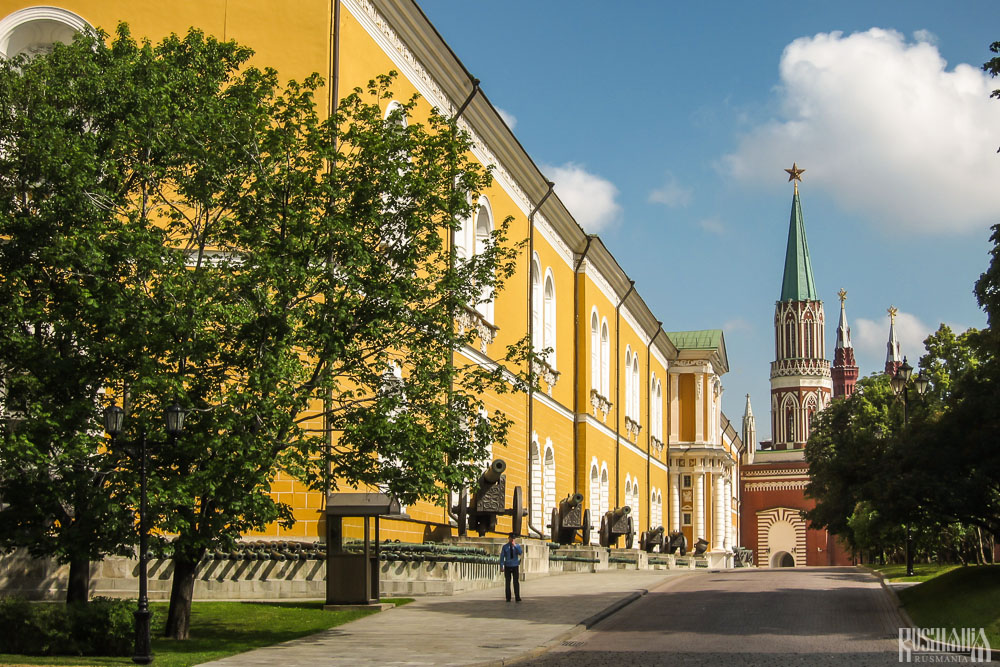 Kremlin Arsenal (June 2011)
Kremlin Arsenal (June 2011)
From Red Square you can see some grand buildings within the Kremlin which are off limits to tourists as they are governmental buildings. As you walk through the tourist entrance to the Kremlin you will see these buildings to your left, but there are plenty of security on hand making sure you keep to the set tourist path away from here. The first building you will see is the Kremlin Arsenal which is recognisable by the cannons and mortars outside which were left by Napoleon upon his retreat from Moscow. The building was originally built from 1702 to 1736, but it was then damaged by fire and by Napoleon's invasion, finally being fully restored between 1816 and 1828. Today the Arsenal is home to the Kremlin Regiment which is the main security service for the president.
Next to the Arsenal is the Kremlin Senate, which for tourists is most visible from Red Square. It was built between 1776 and 1788 according to a plan by Matvey Kazakov. The building is triangular in shape with a courtyard and a circular ceremonial hall in the middle. The Senate currently houses the Russian presidential administration.
The final building here is the Kremlin Presidium (also called simply Building 14) which although similar to its neighbours was built much later between 1932 and 1934 on the site of the former Chudov and Vozneseky Monasteries which were demolished by the Bolsheviks. The Presidium is also used by the presidential administration.
Amusement Palace
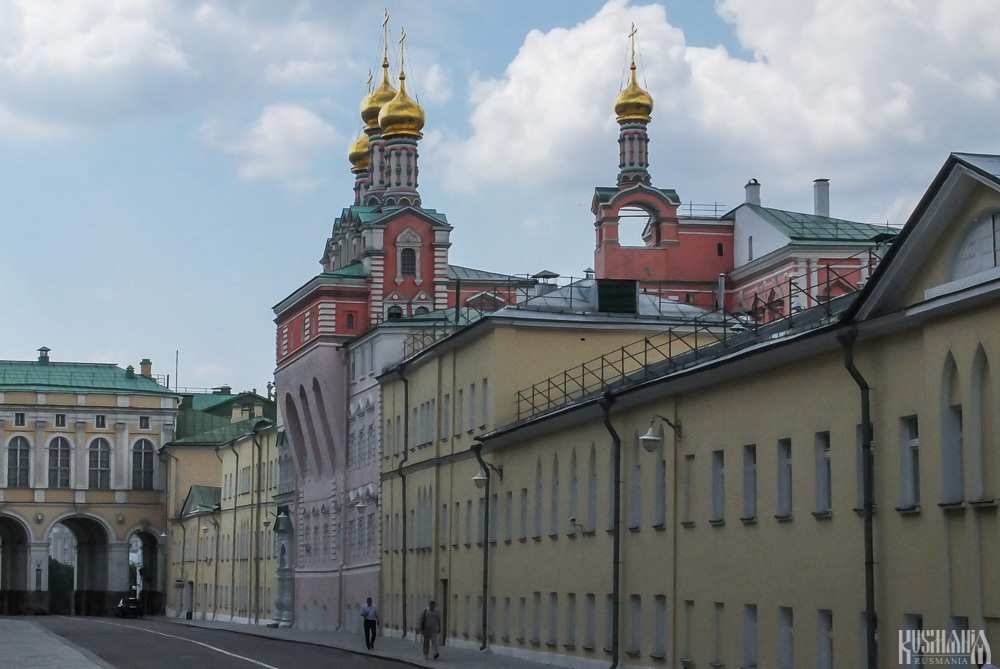 Amusement Palace (June 2013)
Amusement Palace (June 2013)
Up against the western wall of the Kremlin is the Amusement Palace which was built in 1651 for the father-in-law of Tsar Alexis. Afterwards the palace was used as a theatre which explains its unusual name. Included in the structure is the Glorification of the Virgin Church, whose domes were restored between 2000 and 2004. This area is not accessible to the public but you can get a glimpse of it from Aleksandrovsky Gardens and as you walk into the Kremlin.
State Kremlin Palace
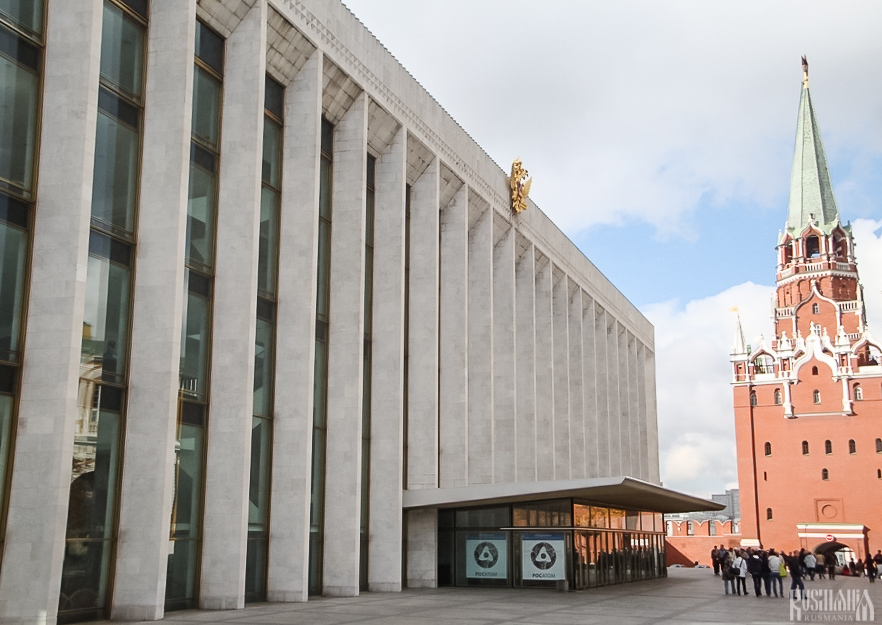 State Kremlin Palace (July 2013)
State Kremlin Palace (July 2013)
The most striking building as you enter the Kremlin is the State Kremlin Palace which, as is immediately obvious, is a Soviet addition to the Kremlin. It was built between 1959 and 1961 and looks completely out of place with its surroundings, so much so that there have been calls to demolish it. Originally the palace was known as the Palace of Congresses and its 6000-seat hall was used to hold congress meetings of the Communist Party. Today the hall is used as a venue for ballet and concerts.
Patriarch Chambers with the Twelve Apostles Church
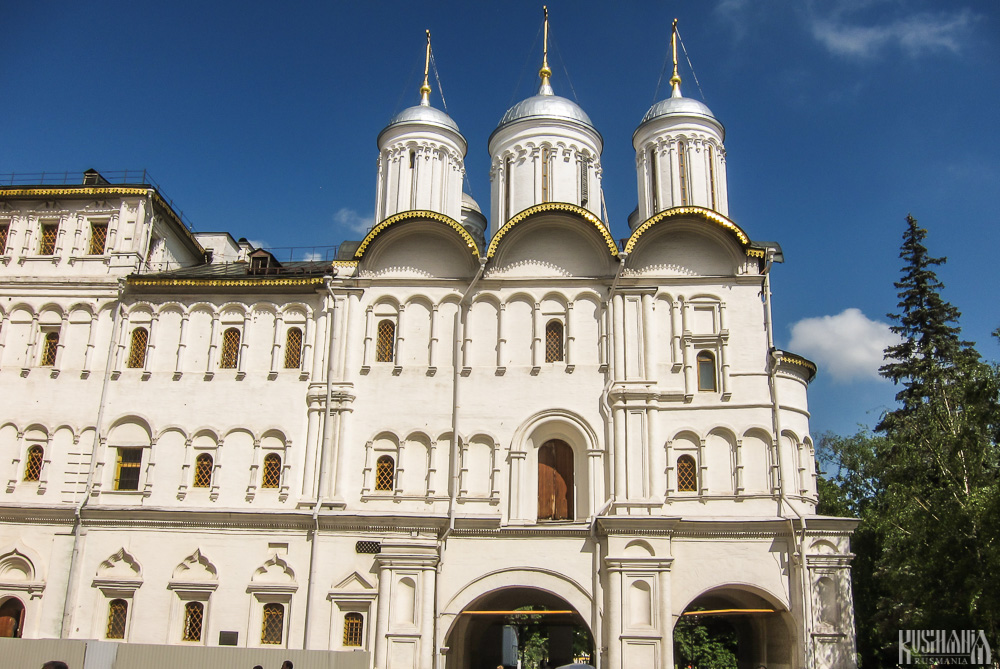 Patriarch Chambers with the Twelve Apostles Church (June 2013)
Patriarch Chambers with the Twelve Apostles Church (June 2013)
Further on pass the State Kremlin Palace is the Patriarch Chambers which were built between 1635 and 1656 on the orders of Patriarch Nikon who wished to create a residence worthy for the co-ruler which he saw himself as. Built on to the chambers is the five-domed Twelve Apostles Church. When Peter the Great abolished the office of patriarch, the chambers were used by the Synod. After the Revolution the chambers were turned into a museum dedicated to 17th century Russian culture and spiritual life. The iconostasis from the Ascension Cathedral was transferred to the Twelve Apostles Church in 1929. In 2005 the Patriarch Chamber's One-Pillar Chamber was restored and now is used to hold temporary exhibitions.
Dormition Cathedral
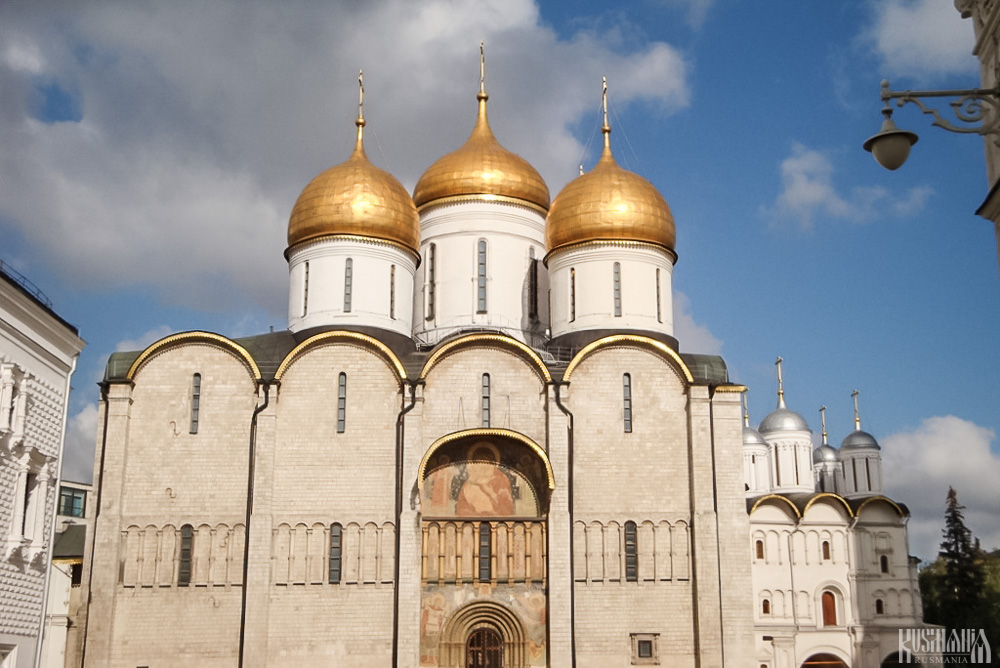 Dormition Cathedral (June 2013)
Dormition Cathedral (June 2013)
The main touristic area within the kremlin is Sobornaya Ploschad (Cathedral Square), so named as there are three cathedrals situated here. The oldest of the three is the Dormition Cathedral. Although an older white-stone version was completed in 1327 to commemorate Moscow becoming the principal city of Rus, the current version was built between 1474 and 1479 on the orders of Grand Prince Ivan III. However work on the new cathedral actually started in 1472 but the unfinished structure was destroyed in 1474 when an earthquake is said to have struck Moscow. For the second attempt Ivan III brought in the Italian architect Aristotile Fioravanti to oversee the work. The result was this six-pillar, five-domed building built out of white stone and brick. In 1812 the cathedral was desecrated by French troops although most of its treasures had previously been evacuated. After the Revolution the cathedral was closed and in 1955 turned into a museum. The cathedral became the place of coronation for Russian tsars and then for emperors and empresses even after the capital was moved to St Petersburg. It also serves as the resting place for many metropolitans of Kiev and Moscow and later patriarchs, whose tombs are scattered around inside. Since 1991 it has been part of the Moscow Kremlin State Historical and Cultural Museum-Reserve, although religious services are very occasionally held here by the Patriarch.
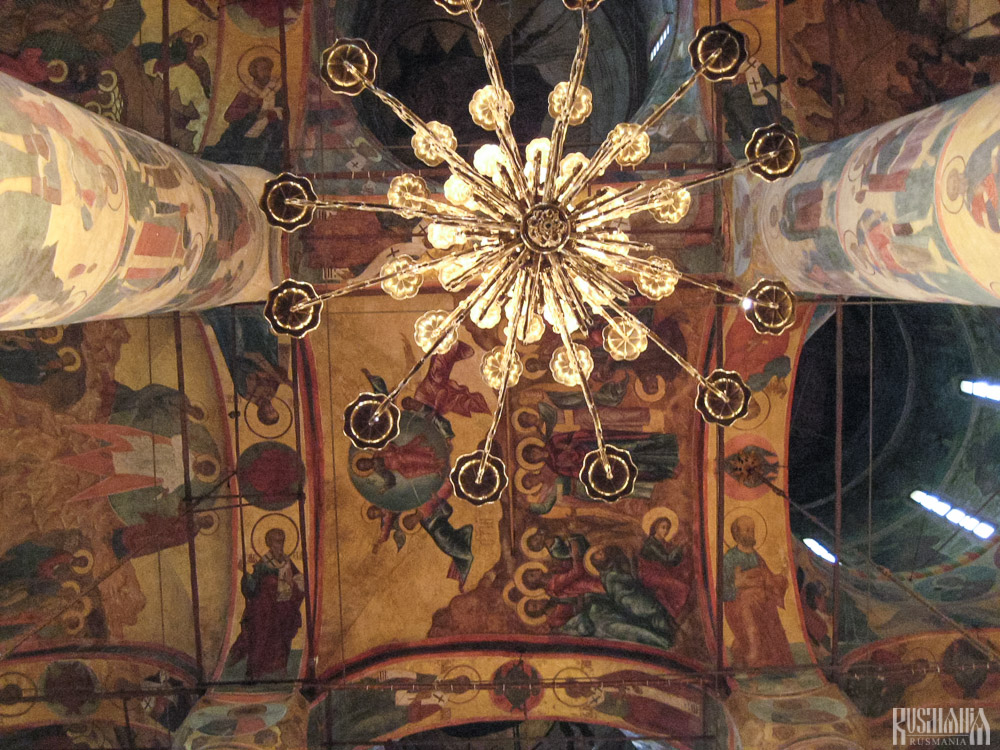 Dormition Cathedral (June 2013)
Dormition Cathedral (June 2013)
The cathedral's first frescos where painted between 1513 and 1515 with the participation of the famous Russian icon painter Dionisius. These frescos though were replaced between 1642 and 1643 and then subsequently renovated throughout the centuries. The cathedral's iconostasis was created in 1653 on the orders of Patriarch Nikon and contains 69 icons. It once also held the Our Lady of Vladimir Icon - Russia's most sacred relic, but the icon was transferred to the State Tretyakov Gallery after the Revolution. Now the cathedral holds a copy from 1514. In front of the iconostasis is the Monomakh throne which was created as the prayer-throne for the tsar in 1551 on the orders of Tsar Ivan the Terrible.
Archangel Michael's Cathedral
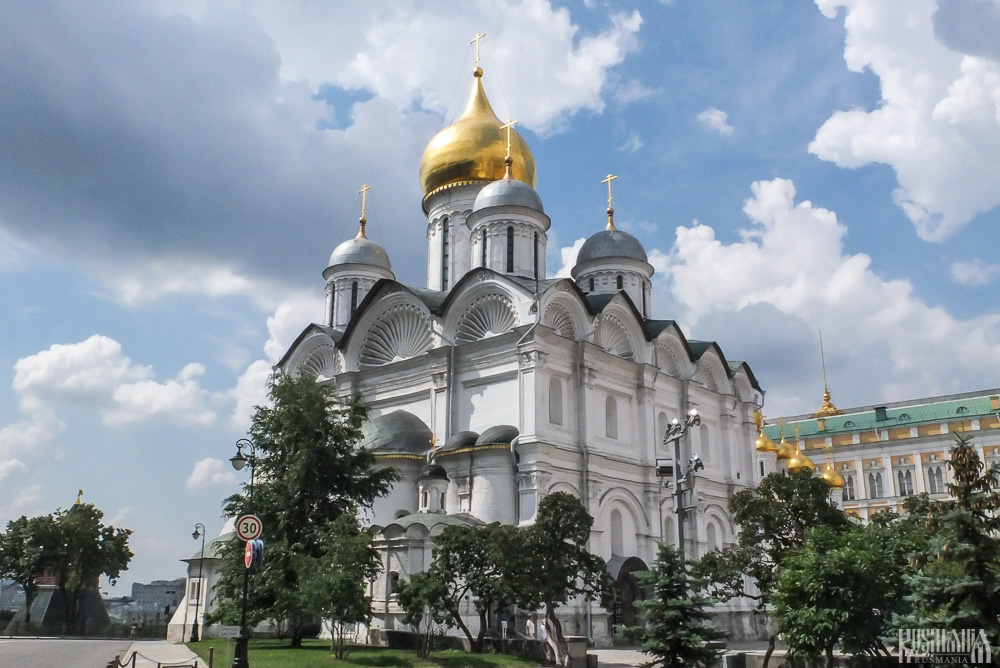 Archangel Michael's Cathedral (June 2013)
Archangel Michael's Cathedral (June 2013)
The "youngest" cathedral in the kremlin is Archangel Michael's Cathedral which was built between 1505 and 1508 to replace an earlier version which dated from 1333. Construction of the new building was overseen by the Italian architect Aloisio the New. Like its neighbour the Dormition Cathedral, Archangel Michael's Cathedral also has six pillars and five domes, but it is more ornate in style. Upon its construction the cathedral became a royal necropolis and inside the sides of the cathedral are filled with large crypts containing the remains of Moscow grand princes and all the tsars before Peter the Great, except Boris Godunov and False Dmitri I. Ivan the Terrible's crypt is here, although in a separate altar not open to the public. His son, Prince Dmitri Ivanovich of Uglich, is given a more prominent place than expected for his position, so as to prove that he did die in Uglich and the subsequent imposters were just that. Only one emperor of Russia is interred here - Emperor Peter II, who happened to have died in Moscow. The majority of other emperors and empresses from Peter the Great onwards are buried in St Petersburg.
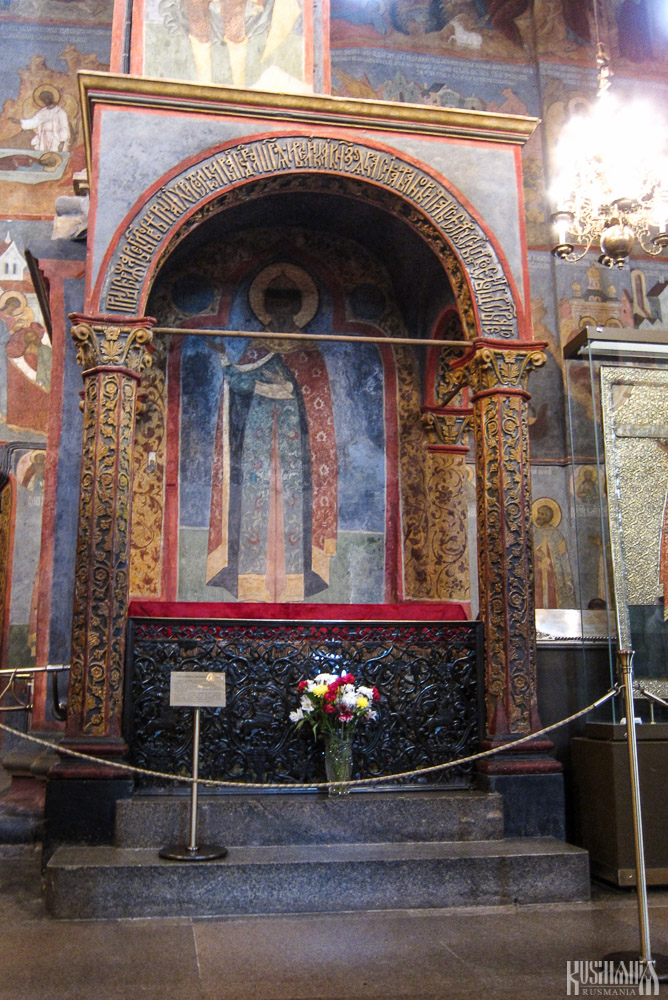 Tomb of Prince Dmitri of Uglich, Archangel Michael's Cathedral (June 2013)
Tomb of Prince Dmitri of Uglich, Archangel Michael's Cathedral (June 2013)
The interior of the cathedral was first decorated with frescos between 1564 and 1565. These original frescos though were damaged during the Times of Troubles and restored between 1652 and 1666. Over the centuries they have been renewed several times, most recently between 1978 and 1980. The cathedral's iconostasis has four tiers containing icons mainly from the 17th century, although the Archangel Michael Icon dates from the late 14th century and, according to legend, was a gift from Dmitri Donskoy to his wife.
Annunciation Cathedral
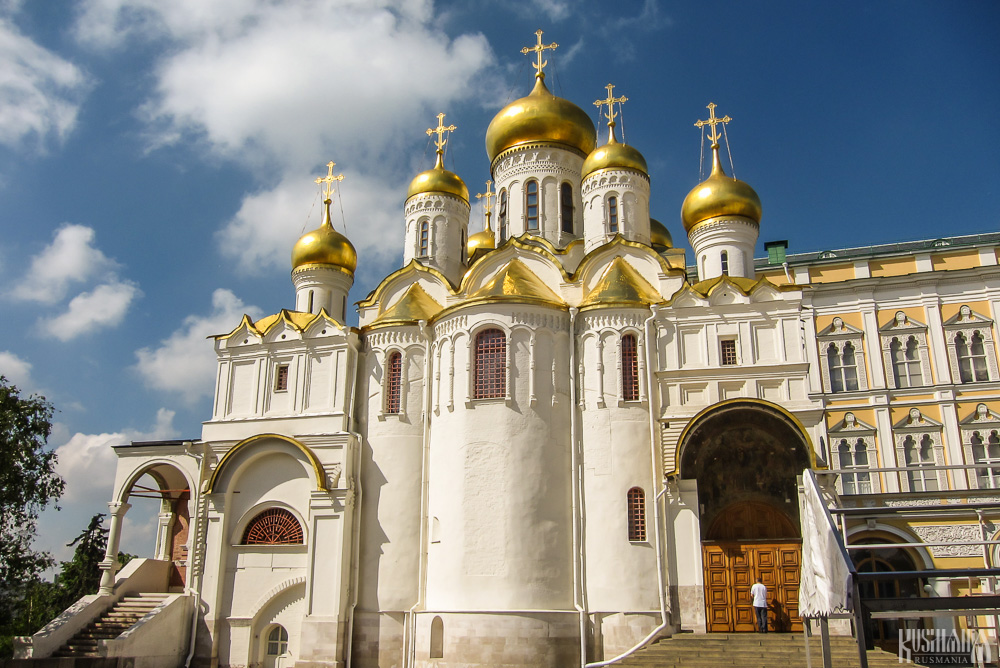 Annunciation (June 2013)
Annunciation (June 2013)
The second oldest cathedral on Sobornaya Ploschad is the Annunciation Cathedral which was built between 1484 and 1489 by master architects from Pskov. Of the three cathedrals it is the most ornate in design with nine gilded domes. The cathedral was considerably damaged by fire in 1547 and afterwards it was decorated with frescos, which have been restored several times since. The frescos include depictions of grand princes of Kiev, Vladimir and Moscow. The cathedral now holds an exhibition entitled Treasures and Antiquities of the Moscow Kremlin, which displays many ancient weapons, coins and jewellery.
A new museum has been opened in the cellar of the Annunciation Cathedral entitled Treasures and Antiquities of the Moscow Kremlin. The museum displays ancient examples of weapons, armour, jewellery and coins which were found during archaeological digs in the territory of the Moscow Kremlin.
Deposition of the Robe Church
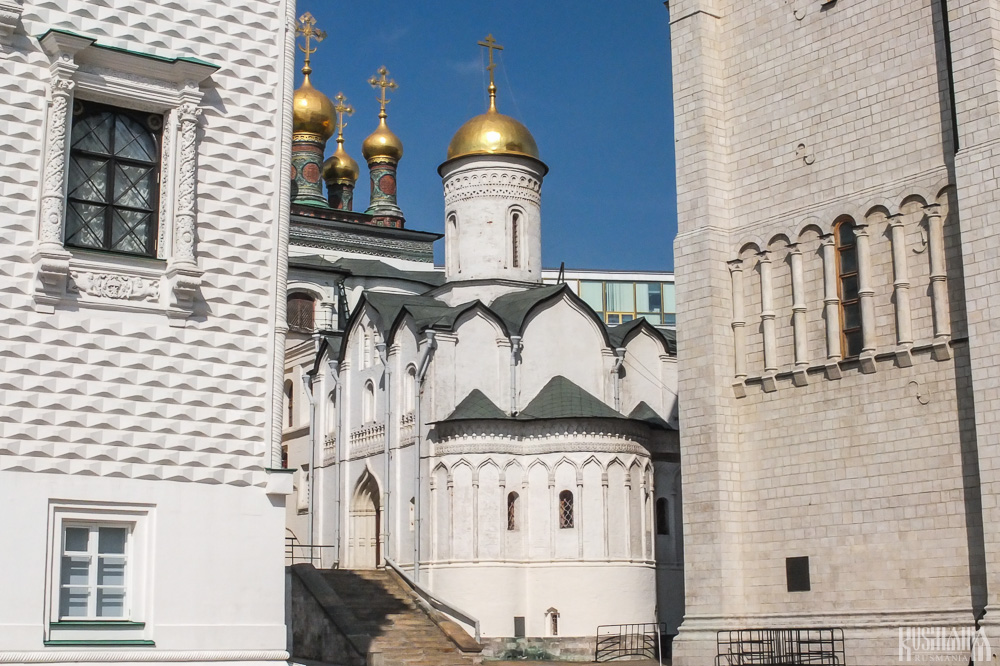 Deposition of the Robe Church (June 2013)
Deposition of the Robe Church (June 2013)
The small Deposition of the Robe Church was built between 1484 and 1485 by masters from Pskov, although in the Moscow style. Inside, the church's frescos which date from 1644 have been preserved as has the iconostasis which was created on the orders of Patriarch Filaret in 1627. In addition the church now displays candles and religious wooden sculptures.
Ivan the Great Bell Tower
 Ivan the Great Bell Tower (June 2013)
Ivan the Great Bell Tower (June 2013)
Standing at 81 metres tall, the Ivan the Great Bell Tower cannot be missed. Whereas once it was the tallest building in Russia, now it is only the 16th tallest bell tower in the country. It was built between 1505 and 1508 and the Dormition Belfry was built adjacent to the bell tower between 1532 and 1552. In 1600 a new tier was added to the bell tower on the orders of Boris Godunov to bring the height to 81 metres. Upon leaving Moscow, Napoleon ordered the bell tower to be blown up and only the base survived. It was subsequently rebuilt in its original form between 1814 and 1815. Today the bell tower has 24 bells dating from the 16th and 17th centuries. The bell tower holds a museum on the architecture of the kremlin and temporary exhibitions are held in the Dormition Belfry.
Tsar Bell
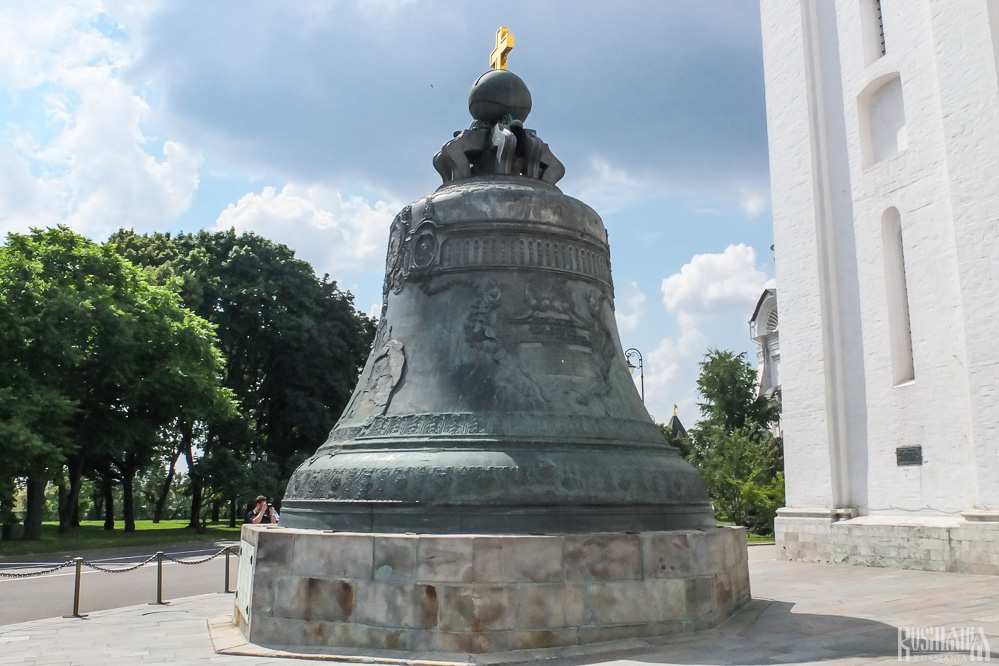 Tsar Bell (June 2013)
Tsar Bell (June 2013)
Located on the ground to the west of the Ivan the Great Bell Tower is the giant 18th century bell known as the Tsar Bell. The bell was cast between 1733 and 1735 by Ivan and Mikhail Motorin on the orders of Empress Anna and is the largest bell in the world weighing almost 202 tonnes and measuring 6.14 metres in height with a diameter of 6.6 metres. However, according to one version of events, in 1737, while the Tsar Bell was still being decorated, a fire broke out in the Kremlin and when water was thrown on the bell to put out the fire a piece weighing 11.5 tonnes cracked off. The wooden supports were also burned resulting in the bell falling back into its casting pit. It was only raised from the pit in 1836. Now it remains as a monument, having never actually been suspended or rung.
Tsar Cannon
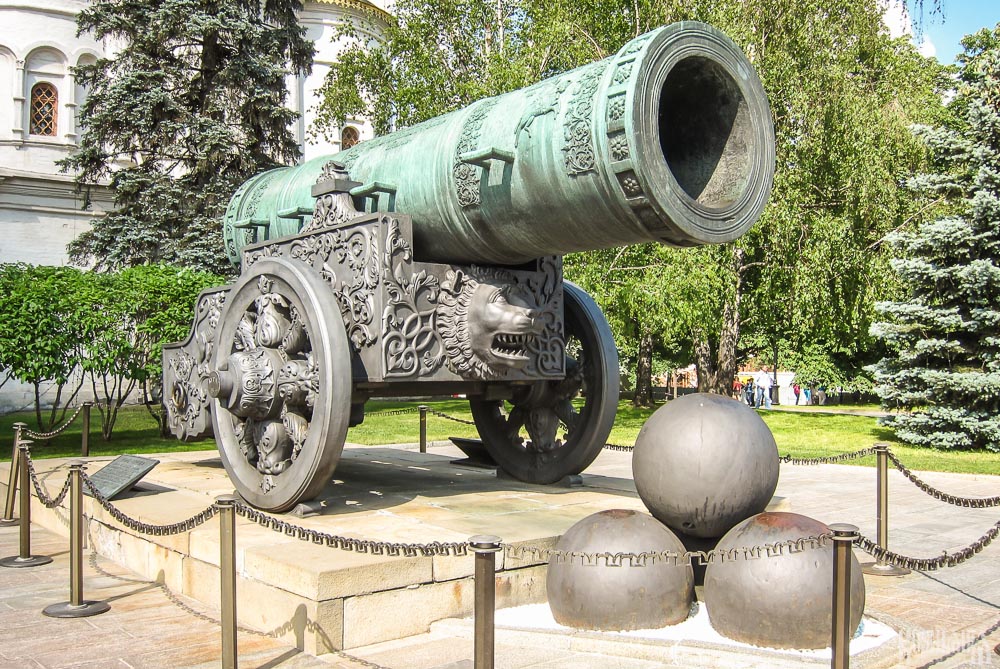 Tsar Cannon (June 2013)
Tsar Cannon (June 2013)
Next to the Tsar Bell is a giant cannon known as the Tsar Cannon. It was cast on the orders of Tsar Feodor I by Andrey Chokhov and decorated with engravings, including one of Tsar Feodor. It is the largest cannon in the world at almost 6 metres in length, almost 40 tonnes in weight and with a calibre of 890mm. However, like the Tsar Bell which never rang, the Tsar Cannon was never used in any conflict due to its size making it too difficult to move.
Grand Kremlin Palace
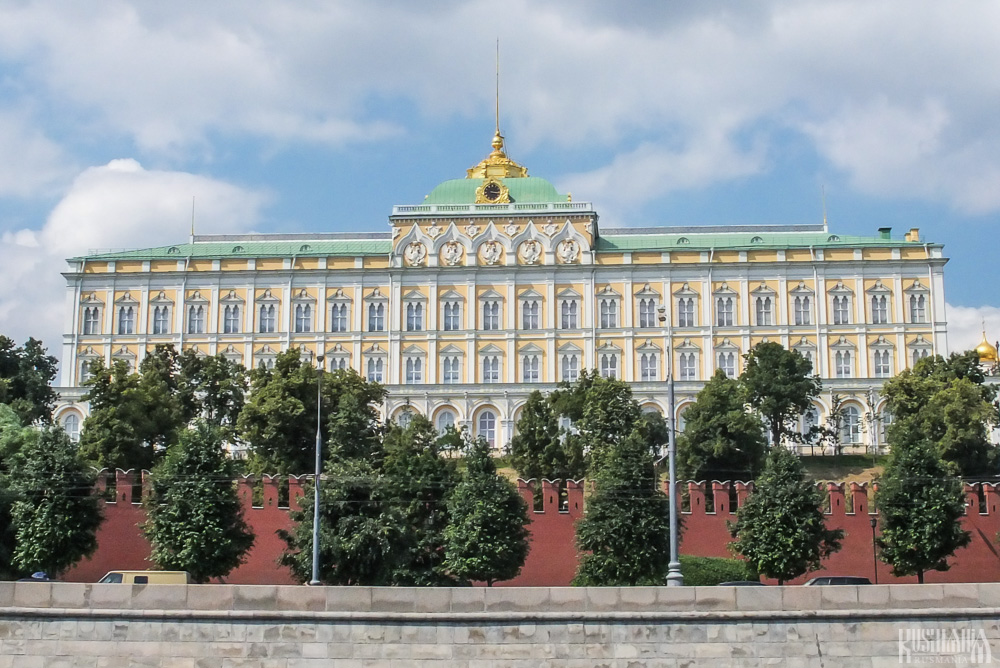 Grand Kremlin Palace (June 2013)
Grand Kremlin Palace (June 2013)
In addition to the religious buildings located inside the Kremlin on Sobornaya Ploschad, there are also several palaces and chambers within the Kremlin. These once served as royal residences, but now constitute the official residence of the Russian president and are used by the government for receiving dignitaries. As such they are not usually open to the public, although some tour firms do offer guided tours.
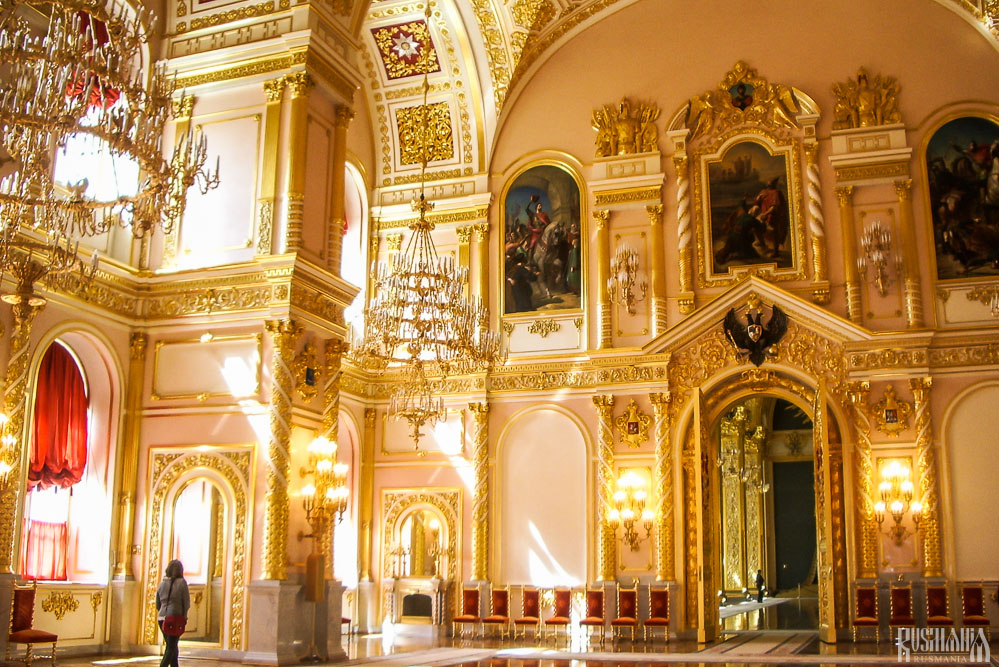 Grand Kremlin Palace (June 2013)
Grand Kremlin Palace (June 2013)
The centre piece of the Kremlin's palaces is the Grand Kremlin Palace which was built on the orders of Emperor Nicholas I under the supervision of the architect Konstantin Ton. The new palace was built on the site of an older residence and as a complex incorporating other palaces and chambers in the Kremlin. The building has two floors, although from the outside it appears to have three floors as the second floor has two rows of windows. The first floor is occupied by the imperial private chambers. The second floor has five grand receptions halls for state functions. These are named in honour of orders of the Russian Empire: Georgievsky (St George), Vladimirsky (St Vladimir), Aleksandrovsky (St Alexander), Andreevsky (St Andrew) and Yekaterinsky (St Catherine).
Faceted Chamber
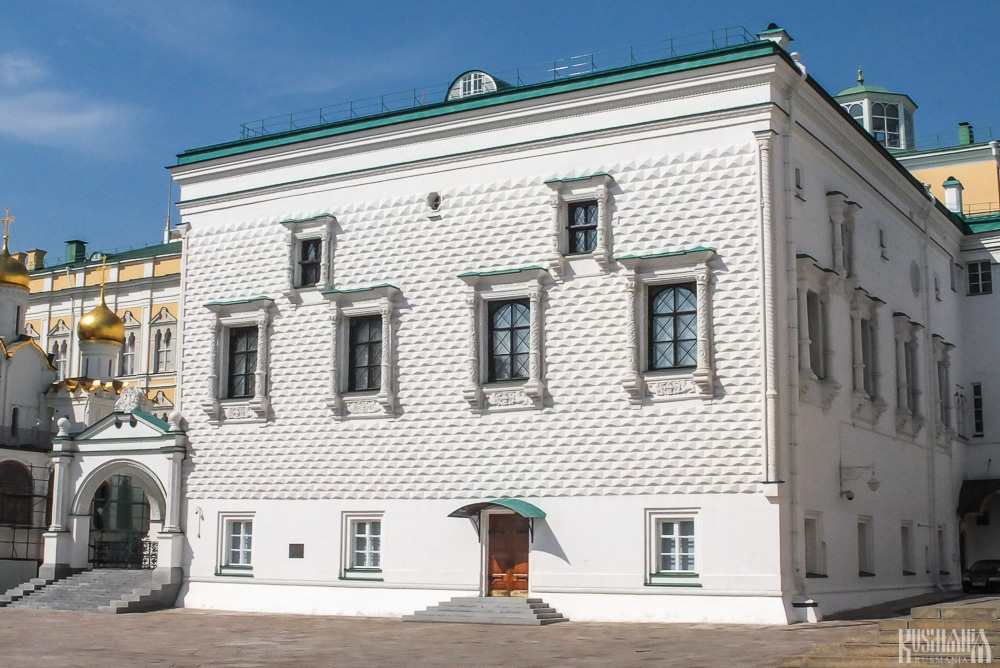 Faceted Chamber (June 2013)
Faceted Chamber (June 2013)
Connected to the Grand Kremlin Palace is the Faceted Chamber which is the oldest surviving civic building in the Kremlin. Its foundation was laid in 1487 by the Italian architect Marco Fryazin on the orders of Grand Prince Ivan III. It gets its name from the fact that the façade facing Sobornaya Ploschad is decorated with faceted white-stones.

Inside the chamber has a ceremonial hall beautifully decorated with frescos depicting bible stories and events from Russian history.
Terem Palace and Upper Saviour's Cathedral
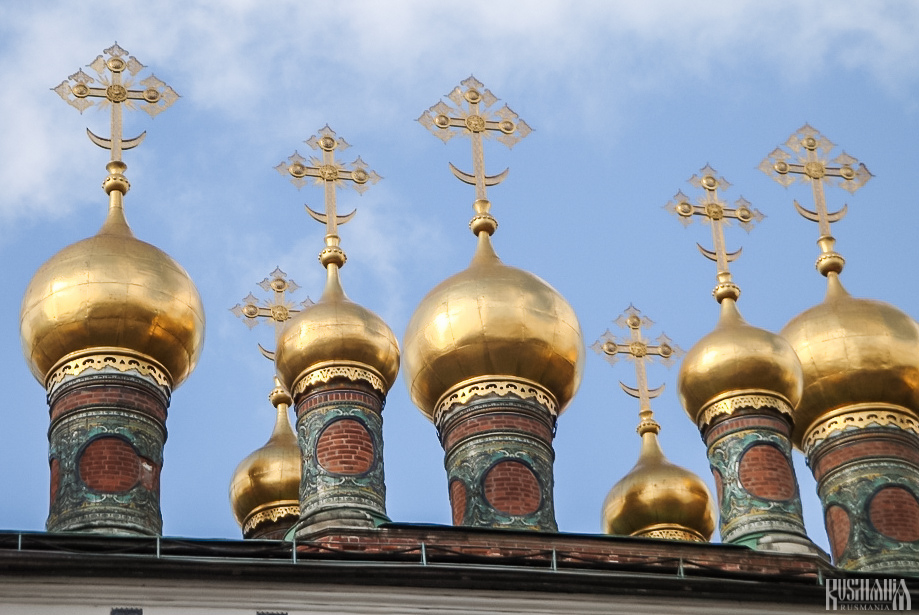 Upper Saviour's Cathedral (June 2013)
Upper Saviour's Cathedral (June 2013)
Behind the Faceted Chamber is the Terem Palace which is the oldest residence in the Kremlin and was built in the traditional Russian style between 1635 and 1636 for Tsar Michael. Its original interior has not survived but it was beautifully recreated in the mid-19th century and then restored in the mid-20th century. Built onto the Terem Palace are several churches which served as the home-churches of the Tsars. For visitors today only the 12 domes of the Upper Saviour's Cathedral are visible as this complex is closed off as part of the official residence of the Russian President.
►sights by districts ►sights in Central Moscow
| Location | Via the Kutafya Tower in Aleksandrovsky Gardens. |
|---|---|
| Metro | Okhotny Ryad, Aleksandrovsky Sad |
| Website | http://www.kreml.ru/en/ http://kremlinpalace.org/en/ |
| Clock | 10:00 - 17:00. Closed on Thursdays. |

